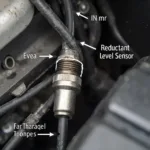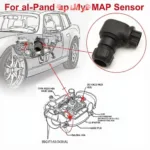Using an OBD2 scanner while the engine is running is crucial for accurate diagnostics. This allows real-time data analysis, providing a dynamic view of your vehicle’s performance and pinpointing issues that might not show up otherwise. Let’s dive into the benefits and intricacies of using your OBD2 scanner with a running engine.
Why Use an OBD2 Scanner with the Engine Running?
Many diagnostic procedures require the engine to be running to accurately assess sensor readings and system operations. A static test, with the engine off, only provides a snapshot of the system’s state. A running engine, on the other hand, allows you to monitor dynamic parameters and observe how various systems interact. This real-time data stream is invaluable for identifying intermittent issues or problems that only surface under specific operating conditions. For instance, a faulty oxygen sensor might only exhibit erratic behavior when the engine reaches operating temperature.
Using an OBD2 scanner while the engine is running is especially beneficial for:
- Monitoring live data: Observe sensor readings in real-time, such as engine RPM, coolant temperature, and oxygen sensor values. This allows you to track changes and identify anomalies as they occur.
- Performing active tests: Certain components require the engine to be running for accurate testing, including fuel injectors, evaporative emission systems, and some actuators.
- Checking for intermittent faults: Issues that only occur under specific driving conditions, such as misfires or sensor glitches, are often best diagnosed with a running engine.
- Verifying repairs: After completing a repair, using an OBD2 scanner with the engine running helps confirm that the issue has been resolved and the system is functioning correctly.
Understanding Data from an OBD2 Scanner (Engine Running)
An OBD2 scanner, when connected to a running engine, offers a wealth of data. It’s essential to understand how to interpret these data points for accurate diagnosis. Each parameter, like engine RPM or oxygen sensor voltage, has a normal operating range. Deviations from these ranges often indicate underlying issues.
Interpreting Live Data
codigos de fallas obd2 provide valuable insights. However, simply retrieving trouble codes is often insufficient for a complete diagnosis. Live data provides the context necessary to understand the code’s implications and its root cause. For example, a lean condition code might be accompanied by high oxygen sensor readings, pointing towards a potential vacuum leak.
Common Parameters to Monitor
- RPM (Revolutions Per Minute): Indicates engine speed. Fluctuations or unusually high/low RPM can point to various problems.
- Coolant Temperature: Essential for ensuring the engine is operating at the correct temperature. Overheating can cause severe damage.
- Oxygen Sensor (O2) Readings: Indicates the air/fuel ratio. Deviations can signal issues with the fuel system, exhaust, or sensors.
- MAF (Mass Air Flow) Sensor: Measures the amount of air entering the engine. Problems with this sensor can affect fuel efficiency and performance.
Advanced Diagnostics with a Running Engine
For more complex issues, an OBD2 scanner can be used in conjunction with other diagnostic tools and techniques.
Bi-Directional Controls
Some advanced OBD2 scanners offer bi-directional control capabilities. This feature allows you to activate certain components, such as fuel injectors or solenoids, while the engine is running. This can be incredibly helpful for isolating faulty components and confirming repairs.
“Bi-directional controls offer a powerful way to actively test components and pinpoint the source of a problem,” says experienced automotive technician, John Miller. “It’s like having a remote control for your car’s systems, allowing for precise diagnostics.”
Using an OBD2 Scanner with a Running Engine: Safety Precautions
While using an OBD2 scanner is generally safe, it’s important to take precautions when working with a running engine.
obd2 scanner monitor offer crucial real-time data. Ensure the vehicle is parked in a well-ventilated area, away from flammable materials. Be mindful of moving parts like the engine fan and belts. Never touch hot engine components while the engine is running.
Conclusion
Using an OBD2 scanner engine running is essential for accurate and efficient vehicle diagnostics. It provides real-time data, allowing you to observe system behavior under operating conditions. By understanding the data provided and taking appropriate safety precautions, you can effectively utilize an OBD2 scanner to maintain and repair your vehicle.
FAQ
- Is it safe to use an OBD2 scanner with the engine running? Yes, but follow safety precautions.
- What data can I see with a running engine? Live data like RPM, temperature, O2 readings, and more.
- Why is live data important? It provides real-time insights into system performance.
- What are bi-directional controls? A feature allowing you to activate components for testing.
- Can I diagnose all problems with a running engine? Not all, but many require a running engine for accurate assessment.
“Using the correct ford ranger obd2 port location is vital for proper connection and diagnostics,” adds automotive expert, Sarah Chen. “Always ensure the scanner is securely connected to avoid interruptions in data flow.”
For further information on OBD2 diagnostics, you may also want to explore resources on obd2 code drive cycle nissan pathfinder 2001 and obd2 battery code ecs.
Need assistance? Contact us via WhatsApp: +1(641)206-8880, Email: [email protected] or visit us at 789 Elm Street, San Francisco, CA 94102, USA. We have a 24/7 customer support team.


